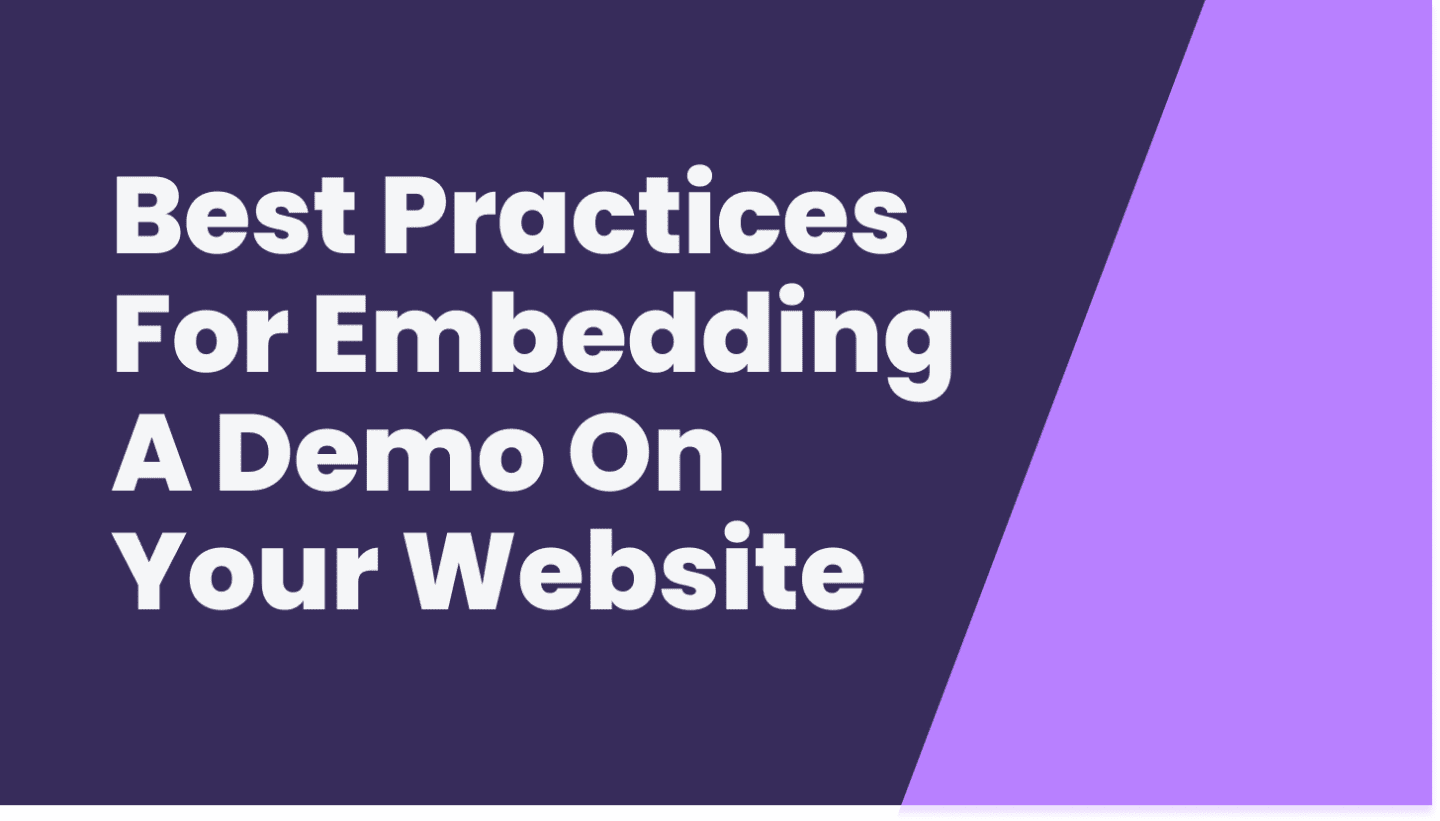Would you buy new shoes without first trying them on?
Well, actually, if we’re being totally honest, we did do a lot of online shopping on Black Friday. But nevermind, we’re just trying to make a point.
If you buy shoes before you try them out, there’s a risk that they won’t fit or they won’t be exactly what you were looking for.
Same goes for SaaS.
That’s where product demos come in handy. They offer a way for prospects to get a sense of what your product is capable of doing before they take the plunge and commit.
But making a demo that gets deals done is no easy job. And if the demo goes awry, it could make a lasting impression that puts your deal in jeopardy.
If you feel your heart starting to race, we get it. But don’t worry.
We’ve put together this article to walk you through the art that is making a highly converting product demo.
- Why are product demos so important for B2B SaaS sales?
- 6 steps to create a converting product demo
- 1) Do your research
- 2) Schedule a demo
- 3) Identify the added value
- 4) Write the demo script
- 5) Encourage engagement
- 6) Send a demo follow-up email
- Product demo close rates statistics
- Delivering personalized product demos that convert
- FAQs about highly converting product demos
- What is the difference between a product demo and a sales demo?
- When do you deliver a product demo?
- Who delivers a product demo?
Why are product demos so important for B2B SaaS sales?
You never get a second chance to make a first impression.
And the product demo is the first impression the prospect will have of your product.
So, you need to pay close attention to how you present the product. Because at the end of the day, no matter how life-changing your solution is, it’s the demo that can either convince prospects to sign on the dotted line or send them running for the hills.
Essentially, the demo is your chance to showcase your product’s unique selling points and how it leaves the competition in the dust.
When done right, you could see several product demo benefits.
While there are many benefits we could talk about, we went ahead and picked the main three:
1. Establish trust: When the prospect can actually see everything the product can do, it helps build a relationship and establish trust.
2. Foster enthusiasm: A demo that engages prospects can help you get them excited and enthusiastic about your product.
3. Address unique needs and pain points: By personalizing your product demo based on the information you’ve gathered, you can show the prospect you understand their specific needs and pain points.
6 steps to create a converting product demo
That’s all fine and good.
But where are you even supposed to start when it comes to creating a deal-winning product demo? Glad you asked!
Here are the 6 steps you should follow to create a highly converting product demo.
1) Do your research
You’re ready to give a killer demo. We love that enthusiasm!
But not so fast!
Before you even think about creating an interactive demo, you’ll need to do your homework.
If you want to convince prospects that your product will change their lives, you’ll need to research and understand them.
This doesn’t just mean knowing their name and where they work. You need to learn as much as you can about their needs and priorities.
To do this, start by Googling the prospect and seeing what comes up. It can also help to check their LinkedIn profiles to not only gather personal information about them, but also learn more about their interests.
Ideally, you’ll use all of this information during the SaaS discovery call to pinpoint the prospect’s unique pain points and get them interested in learning more about your product.
To learn more about improving conversion rates, download the 10 SaaS Sales Commandments.
2) Schedule a demo
You’ve piqued your prospect’s interest. Nice work!
The next step is to send your prospect a demo request email so you can schedule the product demo.
Remember, this email is all about selling a meeting, not your product.
So, to get the prospect to agree to a demo, make sure you’re using the right tone and that you include the right information in your email.
This can be:
1. Why the client should take the time to meet with you
2. What the demo will include
3. Why your product bests the competition
4. How long the demo will be
It’s also essential to craft a punchy subject line and send your emails at the right time.
3) Identify the added value
Your prospect has just agreed to a demo. You are absolutely killing it!
Now, you’ll need to put everything you’ve learned about the prospect into action.
In this phase, the focus should be on those unique pain points and how your product will address them. You’ll also want to highlight why your product is better than the competition’s.
One of our best product demo tips is to personalize your demo with not only the prospect’s name, position, and company branding, but also when it comes to which aspects of the product you showcase.
Because, like it or not, prospects don’t care about every single feature your product has to offer. They just want to see the features that will help solve their specific problems.
4) Write the demo script
Pens at the ready!
Before your demo, it’s a good idea to write a sales demo script that outlines the narrative you will showcase. This will help you appear confident and well-prepared.
To get the script right, you should introduce yourself and your main message, relate the features to the pain points, highlight the unique value proposition, and reinforce the main point as you close.
But just remember, while the script can guide you through the demo, you’ll still need to be flexible and respond based on how the conversation flows.
5) Encourage engagement
You wrote your demo script.
But there’s more you need to do to make a highly converting demo.
You’ll need to make sure you are keeping your prospect engaged throughout your demo. Otherwise, there’s a good chance your demo won’t make enough of an impact to convince the user to sign on the dotted line.
To do this, you’ll need to hear from the prospect themself. Encourage the prospect to answer questions throughout the demo to keep them engaged and interested in what you have to say.
Want to learn more about how to engage prospects? Check out our survey: What SaaS Buyers Really Want.
6) Send a demo follow-up email
The demo was a success!
Do that happy dance, friend!
But unfortunately, a completed demo doesn’t mean the deal is done.
To nudge prospects across the finish line, you’ll need to send a demo follow-up email. This email should include a summary of what you talked about during the demo as well as the next steps.
When done right, these kinds of emails can help you move prospects closer to the end of the sales cycle.
Product demo close rates statistics
It is essential to monitor your product demo close rate to make sure you are staying aligned with your goals.
But how should you go about defining your target? Well, it’ll help to take a look at product demo close rates for other SaaS companies.
According to Belkins, the industry standard for the demo close rate falls at around 20%.
Delivering personalized product demos that convert
When you get the product demo right, it’s like magic.
The prospect will suddenly stop and let out an “aha!” because they now realize that your product is everything they’ve ever dreamed of.
And when it goes wrong, it could be just the thing that poisons your deal.
(No pressure or anything.)
But there are tools you can add to your sales tech stack to make creating a highly converting demo a whole lot easier.
Demo experience platforms (hint, hint: Walnut) allow you to deliver personalized and interactive demos to show prospects that your product is what dreams are made of. Some demo experience platforms even let you track your demo performance so you know how you can make improvements in the future.
Think of it this way. With a demo experience platform, it’s much easier to create software demos that will convince prospects to take the plunge.
FAQs about highly converting product demos
What is the difference between a product demo and a sales demo?
Both a product demo and a sales demo involve showing how a particular product solves pain points and positioning it as the most efficient solution to solve these problems.
But there is one key difference.
While a product demo is given to both potential and current customers, sales demos are specifically given to prospects to get them to sign on the dotted line.
When do you deliver a product demo?
To put it simply, there’s no one right way to answer this question.
Old school product demos typically happen during the later stages of the sales funnel after the lead has been qualified.
However, sales pros that use a demo experience platform like Walnut can share demos with prospects at any point throughout the sales process. And this can help shorten the sales cycle for both buyers and sellers.
Who delivers a product demo?
Typically, a sales rep will deliver a product demo to prospects.
Still not using Walnut? What are you waiting for? Get started by pushing the “Get Started” button.



